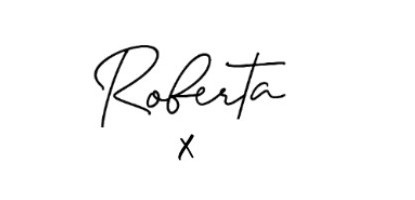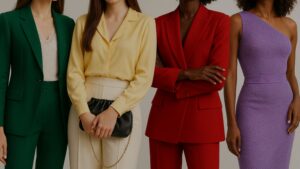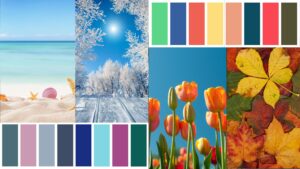I never used to believe in colour analysis. I thought it was a system that middle-aged women used to match their T-shirts, cardigans and neck scarfs. Not something that I could relate to in my twenties. Actually, the idea of colour analysis felt stifling to me. However, from personal experience, I can report that colour analysis is a great tool for anyone who loves style, it actually helps rather than hinders the creative process.

I have always been naturally very good at dressing myself, dressing others, and confident enough to try out different looks and experiment with colours, so I never really felt the need to learn about it. Until one day, my trained colour analyst who was meant to be working with me dropped out of the business due to personal reasons – which meant there was a gap to fill. I decided that instead of finding someone new, I would add colours to my sustainable styling services… and I’ve never looked back!
The truth about colour analysis
After embracing the training and keeping an open mind, I was quite surprised to discover that using colour theory in my work would actually help my clients build more sustainable wardrobes and create less wasteful shopping habits. Here’s what I realised about my misconceptions…
- Colour analysis isn’t meant to stifle you, it’s meant to empower you! You don’t need to get rid of all your old clothes and wear only your colours top to toe, you can approach it any way you like.
- The science behind the analysis does help you understand the colours to eliminate from your wardrobe – and that in itself is priceless! Whilst it wasn’t created with multiple ethnicities in mind, it can be adapted and used to help everyone find their most flattering colours – undertones and contrast are two massively under appreciated elements of our personal appearance that affect how well we can pull off certain colours, materials and patterns. Mind blown…
- Not all colour analysts are personal stylists – and that’s OK! For so long I was stuck on the idea that I would never take advice from a 50-year woman wearing a matching top and cardigan and a fuddy-duddy looking scarf draped over their neck…. What I didn’t realise is that colour analysts don’t have to be stylist and stylists don’t have to be colour analysts, I could see how combining the two could be much more powerful.
- You get to experience colours you’ve never gravitate to on your own, it’s not about someone telling you, its about the drapes introducing you to different types of pinks, greens and blues and in amongst all of the swatches you get to find your WOW colours.
Figuring out your colours on your own
If you have a keen eye for colour and are able to identify sets of colours that do and don’t work for you – you can probably figure out what colours to wear, but knowing if you’re warm or cool is a lot harder to guess! A few other ways to determine if you’re warm or cool includes the vein test (blue veins = usually means cool, and green veins = usually means warm) and the jewellery test (silver = cool, gold = warm, silver and gold = neutral, rose gold = soft and neutral ).
Check our my Wearing Colours Style Guide to find lots of other resources to help you.
If you’re unsure, I recommend taking the guesswork out of it and investing in colour analysis because it’s far too easy to get it wrong. You can opt for virtual analysis or in-person, there are many options that make it more affordable if budget is tight. The key to wearing the right colours is to find the right harmony – and whilst the 4-seasons and 12 tonal seasons is helpful, what’s most important is to find colours that work for your unique colouring and complexion.
DIY Colour Analysis
- Start by determining if you look better in white or cream clothes.
- Look at your contrast and try and determine if its high, medium or low.
- Ensure you are in natural daylight and wrap various colours around your neck and try and identify if the colours make you look grey or yellow, if they do these aren’t quite right.
- Pay close attention to the appearance of your skin when draping colours to test, does it look more tired or illuminated?
- It’s often hard to self-analyse so ask a friend to give you honest feedback if you’re struggling.
If this sounds like too much work, then I recommend you book in with a local colour analyst and have the whole process done properly and then you’ll know for sure if you’re warm or cool-toned, in-between seasons (transitional) or a neutral.

What if I get my colours wrong?
Before I got my colours done by a trained analyst (and personal stylist!) – I thought based on what I had read online (and what another colour analyst had told me) that I was meant to wear warm autumn based colours. After having my colours professionally done, I discovered I was cool-toned – and defined as a true winter. Whilst that was true for me in my early thirties, I have found that with blond hair, and tanned skin that I am able to wear gold jewellery and spring colours a little easier, and now with my own colour harmony knowledge I have realised that it’s OK to stray from a defined colour palette as long as you understand the basics of colour and how your skin and features react to it.
Colour guesswork
The truth is I have always disliked the majority of autumn colours on myself and have always opted for a brighter winter palette. I instinctively knew, certain colours made me ‘shine. Now that’s great for me, but not everyone has a keen eye for these things. But even I still made mistakes… the muted green khaki jackets and mushroom muted tones… these were such popular colours for casual jackets – and I wore these.
Realising what colours are ‘cool’ and ‘warm’ has helped me stay more focused when looking for new clothes for my wardrobe, the biggest revelation for me was finding colours that make my skin look flawless, younger, and more awake without makeup on.
That changed me from anti-colour analysis – to a believer. I always recommend that my clients start with colours, that includes both my male and female clients – it’s beneficial for us all.
Let me know in the comments if you’ve struggled to determine if you’re warm or cool, neutral, or between seasons. Maybe you’ve had your colours done and not felt that the outcome was quite right for you, could you be between seasons?

Check out my other colour- related blogs:
Cool Winter
Cool Summer
Warm Spring
Warm Autumn







2 thoughts on “Does Colour Analysis Work?”
That’s interesting – and it sounds to me that you could be more of a neutral with a slight lean into warmth 🙂 Not everyone fits neatly into a distinct colour analysis box.
When our contrast between our hair and skin changes, it definitely effects the intensity of the colours that we can wear as easily, with the ageing process I find many of clients favour softer colours (not always – but often)
When we have a balance of both warm and cool features, it can sometimes leave draping as you say ‘inconclusive’ – actually all this means is that you are lucky to be able to wear lots of colours from the warm season colour palettes.
I would explore colours within the soft autumn range as these include colours with a medium intensity, not too light, not too deep, not too warm or cool. Sometimes it’s better to simply eliminate the colours that don’t work and then you can experiment with everything else.
Have a look at this blog and let me know if you wear any of the colours shown on the colour swatches https://robertastylelee.co.uk/colour-examples-within-the-12-seasons-of-colour-analysis/
I hope this helps! 🙂
I thought I was cool growing up, as had dark brown hair, very dark olive eyes and very pale skin. Analysis by draping showed in fact I was deep and slightly warm. The problems have been since then, as I have gone lighter haired with age to mid brown (I don’t want to go grey!). If go too warm, look flushed, so have kept it neutral brown and my eyes have changed naturally to a lighter, less warm, but brighter, more obvious green. I have been redone as a soft autumn, a warm autumn, even a bright spring, but no draping has been conclusive!